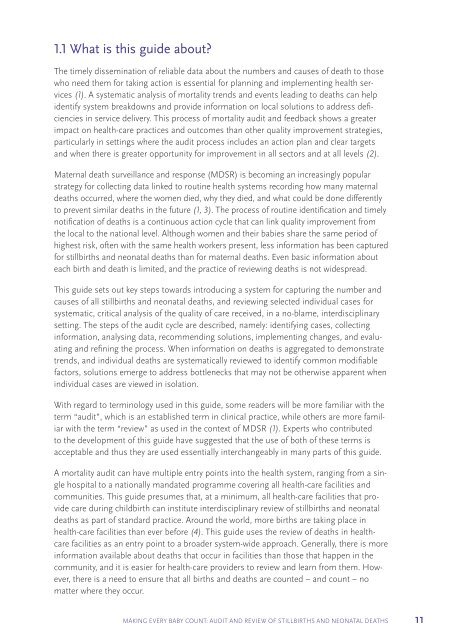Making Every Baby Count
9789241511223-eng
9789241511223-eng
You also want an ePaper? Increase the reach of your titles
YUMPU automatically turns print PDFs into web optimized ePapers that Google loves.
1.1 What is this guide about?<br />
The timely dissemination of reliable data about the numbers and causes of death to those<br />
who need them for taking action is essential for planning and implementing health services<br />
(1). A systematic analysis of mortality trends and events leading to deaths can help<br />
identify system breakdowns and provide information on local solutions to address deficiencies<br />
in service delivery. This process of mortality audit and feedback shows a greater<br />
impact on health-care practices and outcomes than other quality improvement strategies,<br />
particularly in settings where the audit process includes an action plan and clear targets<br />
and when there is greater opportunity for improvement in all sectors and at all levels (2).<br />
Maternal death surveillance and response (MDSR) is becoming an increasingly popular<br />
strategy for collecting data linked to routine health systems recording how many maternal<br />
deaths occurred, where the women died, why they died, and what could be done differently<br />
to prevent similar deaths in the future (1, 3). The process of routine identification and timely<br />
notification of deaths is a continuous action cycle that can link quality improvement from<br />
the local to the national level. Although women and their babies share the same period of<br />
highest risk, often with the same health workers present, less information has been captured<br />
for stillbirths and neonatal deaths than for maternal deaths. Even basic information about<br />
each birth and death is limited, and the practice of reviewing deaths is not widespread.<br />
This guide sets out key steps towards introducing a system for capturing the number and<br />
causes of all stillbirths and neonatal deaths, and reviewing selected individual cases for<br />
systematic, critical analysis of the quality of care received, in a no-blame, interdisciplinary<br />
setting. The steps of the audit cycle are described, namely: identifying cases, collecting<br />
information, analysing data, recommending solutions, implementing changes, and evaluating<br />
and refining the process. When information on deaths is aggregated to demonstrate<br />
trends, and individual deaths are systematically reviewed to identify common modifiable<br />
factors, solutions emerge to address bottlenecks that may not be otherwise apparent when<br />
individual cases are viewed in isolation.<br />
With regard to terminology used in this guide, some readers will be more familiar with the<br />
term “audit”, which is an established term in clinical practice, while others are more familiar<br />
with the term “review” as used in the context of MDSR (1). Experts who contributed<br />
to the development of this guide have suggested that the use of both of these terms is<br />
acceptable and thus they are used essentially interchangeably in many parts of this guide.<br />
A mortality audit can have multiple entry points into the health system, ranging from a single<br />
hospital to a nationally mandated programme covering all health-care facilities and<br />
communities. This guide presumes that, at a minimum, all health-care facilities that provide<br />
care during childbirth can institute interdisciplinary review of stillbirths and neonatal<br />
deaths as part of standard practice. Around the world, more births are taking place in<br />
health-care facilities than ever before (4). This guide uses the review of deaths in healthcare<br />
facilities as an entry point to a broader system-wide approach. Generally, there is more<br />
information available about deaths that occur in facilities than those that happen in the<br />
community, and it is easier for health-care providers to review and learn from them. However,<br />
there is a need to ensure that all births and deaths are counted – and count – no<br />
matter where they occur.<br />
MAKING EVERY BABY COUNT: AUDIT AND REVIEW OF STILLBIRTHS AND NEONATAL DEATHS<br />
11
















